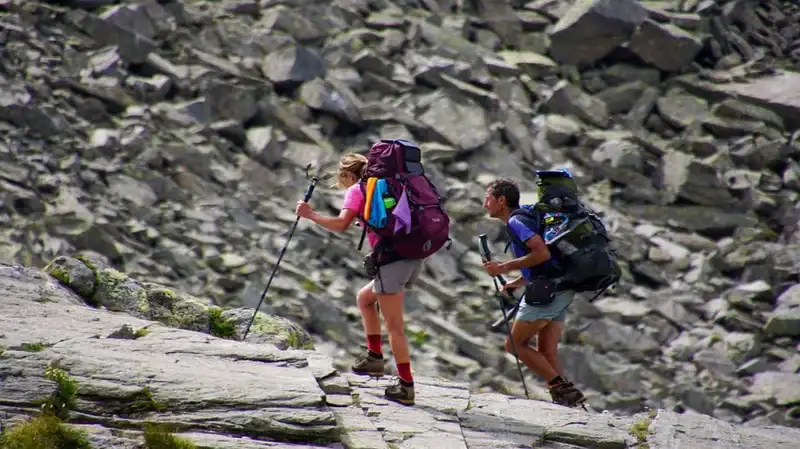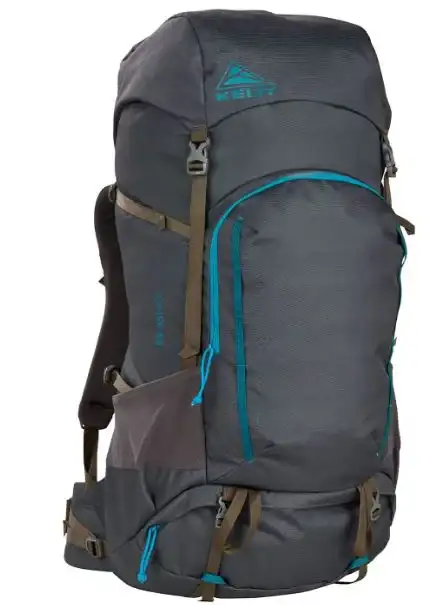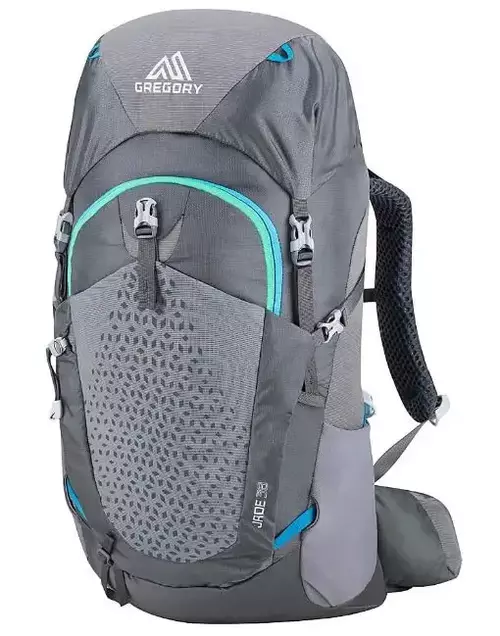Hiking backpacks may be of various sizes, so there is no a single set of specifications that would apply to all of them. But we can make a list of essential features instead, and point out at least some specifications.
I am convinced that it is not possible to make a list of specifications and features of a good hiking backpack that would be accepted by everybody. We all have different preferences.
But it is possible to define some basic principles that are related to specifications and that may help in choosing the right pack. In my view, these are as follows:
- Comfort.
- Versatility.
- Functionality.
- Weight.
Based on these main principles, the desired features and some specifications are listed in the text below.

Carry load capabilities
This is related to the principle of comfort. You want to have a backpack that allows you to carry heavy loads and to do this in a comfortable way. This may imply a variety of features that you want to have, such as:
- A good frame (internal or external) that supports the load and provides its stability.
- A good padding on the shoulder harness, hip belt, and in the lumbar area.
- An appropriate volume for the planned activity and the load.
- Related to the volume, you might want to have a pack with i) an extendable collar, and ii) a floating lid. This is related to the principle of functionality and versatility. So when you are on a tour where you need more stuff in the pack, you expand the collar and adjust the lid. It is typical for Deuter packs that have +5, +10, or +15 liters capacity.
In addition to this, you will want to have options to stabilize the load, and this implies some features like:
- Load lifters straps. This is usually available in all larger packs.
- Side compression straps. This feature is also almost always available. You may have one or two on each side, or sometimes even three. Some packs may have a single zig-zag strap that can be cinched on the top and on the bottom.
- Side hip belt straps. These are specific straps that you may see on some good packs, they are less visible and you will find them behind the hip belt pockets. They pull the hip belt towards the pack.
Examples regarding specifications:
Packs designed for heavy loads, or packs with more features may imply more weight. If you have multiple entry points, this implies extra zippers that add weight. So it is important to find a balance of what is fancy and what is essential.
The Kelty Asher 55 pack in the picture is one good example, it weighs only 1.25 kg, yet it has quite a number of features.

Far more features you have in Gregory Katmai 55 pack, but it is heavier, it weighs around 2.1 kg. Now you see the range of weight to expect in packs of this size that is appropriate for weekend and multi-day tours.
On the other hand, many ultralight packs lack some features that I see as essential. But it is better not to go deeply into the subject because the meaning of essential is very subjective and personal.
Regarding specifications and volume, for a day pack you can have something in the range 15-35 liters. I sometimes carry even a bigger pack for day mountaineering tours.
Regarding carry weight, such day packs should allow you to carry up to 12-15 kg or so. Here is one great series of day packs from Osprey, the Stratos and Sirrus, they include many features discussed here in the text, please have a look:
Adjustability
This is very much related to the principle of comfort and to the carry load capability listed above. If you cannot position your hip belt at the right height, you may suffer and you will not be able to carry the load comfortably.
Now, adjustability may include the following three main elements:
- Adjustability of the shoulder harness. This is usually described as torso length adjustability, the Gregory Jade 38 Pack for women shown below has this feature.
- Adjustability of the hip belt padding. Some good packs allow you to shift padding forward or backward to fit your body.
- Adjustability of the lumbar padding. So yes, there are great packs where you can adjust even padding in this area.
This adjustability includes also the load lifters straps adjustability mentioned above, and hip belt straps adjustability. In addition, you want to have an easily adjustable sternum strap.

This is also related to the principle of versatility. With such adjustability features, several family members can use the same pack for various activities.
Note that there are packs with adjustability features that are suitable for overweight users, you can see more in my separate text.
Organization features
With this I mean the compartments and pockets. So if this is a mid-size or a large pack, you would want to have a separate bottom compartment.
Some packs have a separate zippered compartment behind the harness for a water reservoir. This is convenient because you have an easy access when it is necessary to refill the water bladder.
As for pockets, the more the better, this is how I see it. I particularly love to have side zippered bellows pockets in addition to all other pockets, as well as hip belt pockets. Such zippered size pockets are typical for some packs of Deuter and Kelty.
A good number of pockets would be around 6, but if your pack has more, this is excellent. Typically, you will have two hip belt pockets, two side stretch mesh pockets, one large front pocket, and one or two top pockets.
Access options
This is related to organization features mentioned above. Different compartments imply separate access points. So in addition to to the top access, some good packs also come with a front U-shaped zippered access or with a side J-shaped zippered access. The Gregory Jade 38 Pack for women shown above has a top access and a front access.
If you have a bottom compartment, this implies a bottom access as well. So regarding specifications, you can have 1-3 access points. You may need 2 or 3 in larger packs, but for day packs this is completely unnecessary, it may just add useless weight because of extra zippers.
Examples of such larger packs you can see in this video that presents Gregory Katmai and Kalmia series:
Attachment loops and straps
Here, the same is as with pockets, the more loops the better. You can carry many items attached to the pack. This applies to trekking poles, an ice axe, a tripod, a hatchet, skis, a sleeping pad, a riffle, etc.
Attachment options for a daypack, or even an integrated daypack
Some packs from top brands come with webbing loops on the front where you can attach their separate daypacks. This you have in Osprey and also in Deuter packs.
But some larger packs also come with an attached and removable daypack. There are really ingenious designs of this type. In some packs of Osprey you have a lid that transforms into a fully-featured DayLid daypack. The Osprey Aether Plus 60 pack in the picture below has this feature.

In some packs from Gregory, the inner hydration sleeve is removable, and it doubles as a daypack.
Durability & reliability
The last thing you want on the trail is a broken buckle or similar failures. In this sense, my favorite packs are Deuter. Those are built to last for many years. One of them I have been using for 19 years already.
This issue is also related to the fabric denier value. The rule here is simple, the higher the better, but this may add weight. For example, the Kelty Asher pack has 600D and 420D fabric combination. This is simply excellent and the pack is very light.
On the other hand, Deuter Futura Air Trek come with 210D and this can be taken as quite typical, a similar value you will see in other top brands’ packs.
But see also the Deuter Aircontact X Backpack, it comes with a combination of 330D and a 1000D textured polyamide and with incredible features.
Protection of the equipment
By this I mean primarily a rain cover. For me this is a must, but I know that for some people this is not so.
Indeed, if you are in the area without much rain, no need to carry such an item. You can use the corresponding rain cover pocket for some other purpose.
Ventilation
This is related to the principle of comfort. Practically all top brands now build ventilated packs with a trampoline type tensioned mesh instead of a back panel.
Final thoughts
To summarize, there are many possible features in hiking backpacks that may be useful, but they also add weight. On the other hand, the weight as a parameter is also dependent on the pack’s volume. In this sense, it is better to speak about volume-to-weight ratio than about the weight in absolute sense.
So in terms of specifications, if you see a pack with a volume-to-weight ratio 35-40 liters/kg, you can be sure this is a very light pack. But check also the pack’s features, because some useful features may be missing.
Typically, you will have a feature-rich pack with around 25 liters/kg volume-to-weight ratio. In most cases, the more features the heavier the backpack. The important question is: do you really need them all?
You might want to read also about differences between men’s and women’s packs. Thank you for reading. There is a comment box below, so let me know if you have questions.
Subscribe to my weekly newsletter, this will keep you informed because I add texts here regularly. Have a nice day.
Leave a Reply